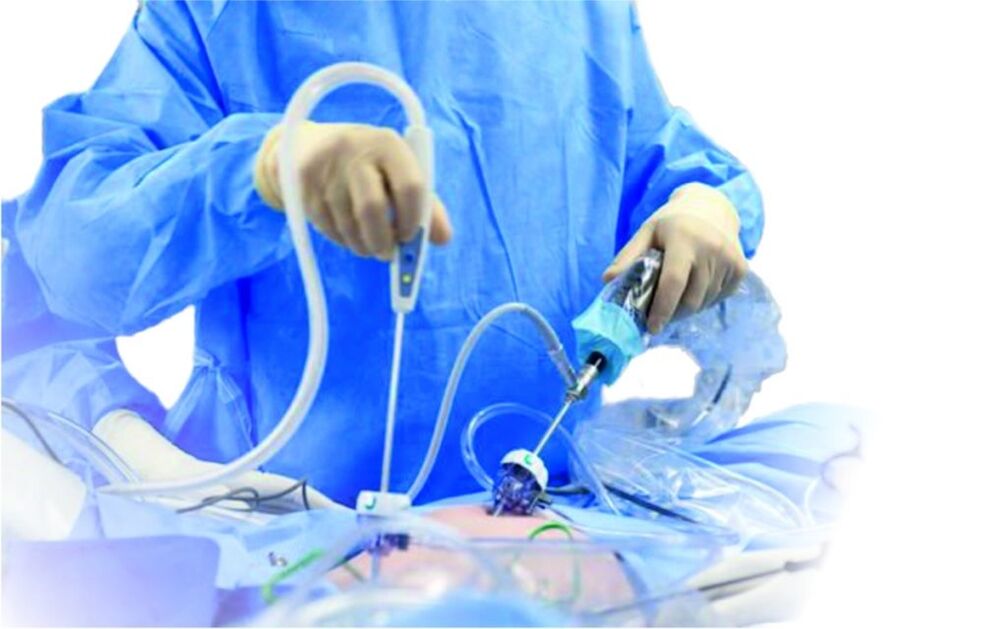Prostatitis is an inflammatory disease of the male prostate gland, which is located directly below the bladder and secondary part of the genitals.
Prostatitis over 7 years of age over 35 years of age and each naked risk of the inflammatory process of the prostate increases as a result of external and internal factors.
Reasons

Inflammation of the prostate gland can occur for various reasons, doctors distinguish the main:
- Violation of blood microcirculation in the pelvic organs - this leads to stagnant processes and promotes increasing the size of the prostate. Stagnant processes are facilitated by obesity and conduct of sedentary lifestyle.
- Bacteria, viruses, or protozoa penetration in the tissue in the background of the acute or chronic inflammatory process in other organs in the body - diseases such as angina, gonorrhoea, uretritis, cystitis, influenza, influenza, pyelonephritis. The causal agents of the infection can enter the prostate with blood flow and lymphatic when there is an infection in distant areas and organs.
- Injuries and bruises of the abdomen, perineum and external sexual soft tissues - this leads to edema and damaged blood circulation in the harmful zone;
- Body hypothermia.
- Chronic constipation.
- Hormonal disorders.
- Stormy or vice versa, missing sex life is harmful, both are common sex (more than 1 times a day) and rare intimate relationships (less often once a week), as this leads to depletion or prostate stagnation.
Symptoms of prostatitis
A distinction should be made between the acute and chronic form of the disease.
Acute prostatitis is characterized by a sudden beginning with the general well background accompanied clinically by the following symptoms:
- chills and weakness;
- General Maliuse;
- increased irritability and nervousness;
- increasing body temperature (not exceeding 37, 5 degrees);
- pulling or cutting pain in the lower abdomen and perineum;
- Often urge urination while preserving the feeling of incomplete emptying of the bladder;
- River pain and difficulties with bowel movements.
In the absence of diagnosis and timely treatment, acute prostatitis can be complicated by a purulent procedure and the release of PU -K from the urethra during urination.
Signs of chronic prostatitis
When transition to the chronic form of the disease, clinical symptoms of prostatitis are alleviated and the patient seems to be healing. The characteristic properties of the chronic inflammatory process are burned along the urethra in the prostate gland, with irradiation on the legs that can be improved during urination and emptying. Gradually the disease progresses and causes impotence. Chronic prostatitis means periods of remission and aggravation, but even at the time of aggravation, symptoms are wiped out, not as pronounced as in an acute form. The following symptoms occur clinically:
- difficulties with erection;
- the inability of gender relationship with ejaculation;
- a decrease in sexual desire;
- selection from the mucous membrane of the urethra with a mixture of white flakes;
- feeling of incomplete emptying of the bladder;
- Pulling pain in the lower back, pubis and groin;
- A weak flow of urine - this as a result of narrowing the urethra lumen is observed as opposed to the background of the increased prostate compression.
The chronic slow inflammatory process of the urethra irritates the pelvic nerve endings and provokes constant urine, especially at night. Many people are embarrassed to see a doctor with such a delicate problem, which increases the risk of serious complications such as complete erectile dysfunction, infertility and even prostate cancer.
In addition, in the focus of chronic blood flow prostate, pathogens enter the kidneys, causing acute inflammation, urinary tract retention and increases the risk of renal failure.
Constant accumulation of urine in the bladder and urethra creates favorable conditions for the formation of salts crystals and then for the formation of stones - in men, prostatitis is very often parallel to urolithiasis.
Diagnostic methods
Diagnosis, treatment and prevention of prostatitis is performed by a doctor urologist. To produce the diagnosis, it determines the shape and cause of the inflammatory process in the prostate gland, requires a number of tests:
- The prostate's palpation - through the rectum and allows the size of the size, pain, PU -K or mucous membrane to be detected after palpation;
- Small discharge from the urethra - the resulting material is sent to the laboratory;
- Urinary analysis is general, etc. ;
- Ultrasound of pelvic organs and prostate gland.
If the pathological process is suspected of spreading the pathological process for the patient, the patient is also performed with cystoscopy - examining the bladder wall with an elastic device equipped with an optical system.
In the diagnosis of prostatitis, it is very important to distinguish the pathological process from the adenoma of prostate and other urological diseases with a similar clinical course.
Treatment

The treatment of the acute and chronic form of prostatitis is different, so patients are strongly recommended not to walk on their own.
The acute non -bacterial form of prostatitis is comprehensively treated using herbal preparations and anti -inflammatory drugs.
Treatment of acute bacterium -prostatitis
The principles of the therapy of the acute form of bacterial prostatitis depend directly on the symptoms of the disease.
A distinctive feature of bacterial prostatitis is the acute beginning and rapidly increasing signs of body intoxication - nausea, vomiting, headache, high body temperature. The process of bladder emptying is accompanied by cutting pains in the lower abdomen and perineum, which are given in the lower back. Very often the purulent process is connected and the abscess develops.
Acute bacterial prostatitis is treated in a hospital as the patient's condition can be extremely severe. Therapy consists of a complex approach:
- The patient should take into account the rest of the bed;
- Antibiotics are prescribed - macrolides, fluoroquinolones, cefalosporins;
- We select the preparations that improve the microcirculation of the blood in the pelvic organs. Ensure the outflow of lymph and venous blood, which reduces the severity of edema and the inflammatory process of the prostate;
- Inside, medicines from non -steroid anti -inflammatory drugs are presented. These drugs not only reduce the inflammatory process, but also eliminate pain syndrome;
- painkillers - take tablets inside or introduce rectal candles into the rectum;
- The physiological solution of the glucose sodium has been intravenously prescribed intravenously to eliminate body intoxication.
Important! Prostate massage is strictly prohibited as the risk of sepsis is high.
Surgery
The surgical intervention of prostatitis is only necessary if the patient has a sharp delay in the urine and there is no way to empty the bladder. It cannot be done without surgery and in the case of the prostate gland abscess.
The process of treatment for prostatitis lasts for 14 days, and the patient again performs a comprehensive examination to assess the efficiency of treatment. If necessary, the treatment process will be extended and adjusted.
Chronic treatment
Treatment of chronic prostatitis is different and depends largely on the stage of the pathological process. When the inflammatory process is exacerbated, therapy is performed similarly to acute prostatitis.
Treatment of chronic prostatitis during remission is as follows:
- Entry a course for non -steroid anti -inflammatory drugs. Drugs twice a day for at least 3 days, sometimes for 5 days.
- Preparations that contribute to improving the outflow of venous and lymphatic.
- Immunomodulators.
- Antidepressants and sedatives promote normalization of sleep and eliminate irritability.
- Zinc, selenium, and vitamins in Group V are complexes.
During the remission phase of the inflammatory process of the prostate, the patient is illustrated by physiotherapeutic treatment:
- prostate massage;
- ultrasound;
- electrophoresis;
- magnetic therapy;
- Microwave hyperthermia.
Surgical treatment of chronic prostatitis
In the case of neglected chronic prostatitis, the patient sometimes needs surgery. There are two ways to perform:
- transuretral resection;
- prostatectomy.
Transuretral resection
This method of surgical treatment refers to minimally invasive interventions, although it is performed in general anesthesia. During the procedure, Resectoscope is introduced under the urethra, through which electric electric pulses are transported. These electrical pulses affect the principle of electrical noise and partially remove the prostate tissue. The huge plus of this method of intervention is the lack of blood loss, as the electrical waves not only remove the modified tissues of the prostate, but also immediately treat the blood vessels and prevent bleeding.
Transuretral resection greatly facilitates the patient's condition - after surgery, urination is restored, one is no longer burning on the feet and does not jump into the toilet at night. The erectile function and normal ejaculation are also restored. The full process of the operation is controlled by a doctor on the monitor screen, so the risk of complications during or immediately after minimal.
Prostatectomy

Prostatectomy is a serious abdominal operation and is always associated with the patient's risks. During surgery, the doctor completely removes the prostate gland or much of it. The healing period is 4-6 weeks, high risk of developing postoperative complications, but sometimes this method of surgery is the only way to alleviate the patient's condition and eliminate the consequences of severe prostatitis.
Other methods of treating chronic prostatitis
Other methods of treating a chronic form of prostatitis are as follows:
- Hirudotherapy - or treatment with leeches. Medical leeches are installed on the inflammatory zone, which is released in the process of their actions with saliva, which arranges blood, which eliminates stagnant phenomena and rapidly relieves the inflammatory process. The leeches are used only for special, medical and individual persons in each patient. After the procedure, the doctor puts the used leeks in a Descretor in which he dies. It is optimal to transfer at least 5 hirudotherapy courses.
- Cryodestruction - Liquid nitrogen is used. This treatment method is presented to patients who are poorly used in medication and is contraindicated for some reason.
- Microwave Therapy in a special way - electromagnetic waves affect the prostate gland. After 1 procedure, tissue edema is reduced, blood circulation is normalized and stagnation is eliminated. After completing electromagnetic treatment, the patient completely restores urine and erection.
- Treatment with ultrasound waves - allows rapid stopping the inflammatory process during the remission phase and ultrasound treatment is not done during aggravation. Medicines can also be used to enhance the therapeutic effect, which cause ultrasound directly into the prostate tissue.
- Urethral stenting - The essence of the procedure is to install a special stent on the urethra that expands the urethra lumen and promotes normal urethral outflow. Despite the effectiveness of the procedure, stenting of the urethra only eliminates the clinical symptoms of prostatitis, but does not save the patient from the chronic inflammatory procedure.
Consequences and complications
In the absence of qualified therapy, prostatitis moves rapidly, gets into its current chronic form and threatens human health with severe complications, including:
- urolithiasis;
- pyelonephritis;
- abscess development;
- The spread of the inflammatory process to the testicles and seeds, which leads to infertility;
- erection dysfunction and impotence;
- Necrotic changes in the tissues of the prostate gland.
Occasionally, prostatitis and chronic stagnating processes give momentum to adenoma and then degenerate into prostate cancer.

































